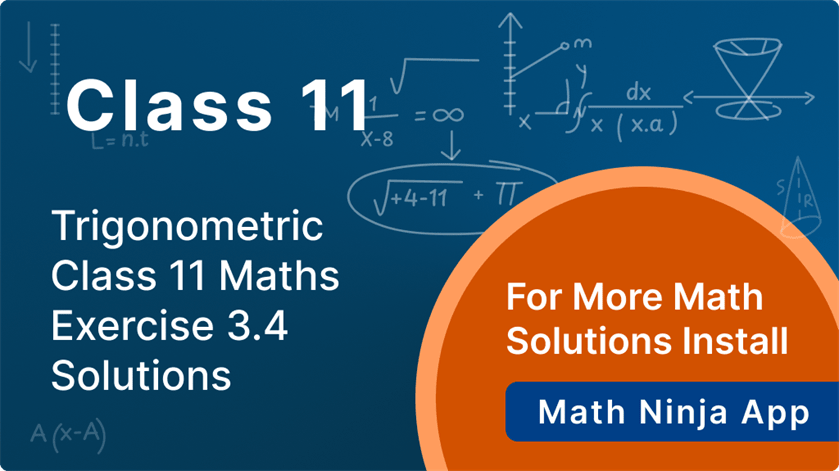Class 11 maths exercise 3.4 solutions | exercise 3.4 class 11 maths solutions | class 11 ch 3 exercise 3.4 solutions | class 11 chapter 3 exercise 3.4 solution | class 11 maths ncert solutions chapter 3 | ncert solutions for class 11 maths chapter 3 | ncert exemplar class 11 maths | trigonometric functions class 11
Looking for Class 11 Maths Exercise 3.4 solutions? You’re in the right place! This section provides detailed and accurate solutions to all the questions from Exercise 3.4 Class 11 Maths, part of Chapter 3 – Trigonometric Functions. These step-by-step explanations are based on the latest NCERT solutions for Class 11 Maths Chapter 3 and are ideal for students looking to understand the properties and graphs of trigonometric functions. Whether you’re searching for class 11 ch 3 exercise 3.4 solutions or practicing from the NCERT Exemplar Class 11 Maths, these resources will help you grasp key concepts with clarity. Master trigonometric functions Class 11 with these well-structured and exam-ready solutions. Download or view now to boost your preparation!

class 11 chapter 3 exercise 3.4 solution || exercise 3.4 class 11 maths solutions || class 11 maths ncert solutions chapter 3 || ncert solutions for class 11 maths chapter 3 || ncert exemplar class 11 maths || class 11 ch 3 exercise 3.4 solutions || class 11 maths exercise 3.4 solutions || trigonometric functions class 11
Exercise 3.4
it is known that \( \tan \frac{\pi}{3}=\sqrt{3} \)
and \( \tan \left(\frac{4 \pi}{3}\right)=\tan \left(\pi+\frac{\pi}{3}\right)=\tan \frac{\pi}{3}=\sqrt{3} \)
Therefore, the principle solutions are \( x=\frac{\pi}{3} \) and \( \frac{4 \pi}{3} \)
Now, \( \tan x=\tan \frac{\pi}{3} \)
\( =x=\mathrm{n} \pi+\frac{\pi}{3} \), where \( \mathrm{n} \in \mathrm{Z} \)
Therefore, the general solution is \( x=\mathrm{n} \pi+\frac{\pi}{3} \), where \( \mathrm{n} \in \mathrm{Z} \)
class 11 chapter 3 exercise 3.4 solution || exercise 3.4 class 11 maths solutions || class 11 maths ncert solutions chapter 3 || ncert solutions for class 11 maths chapter 3 || ncert exemplar class 11 maths || class 11 ch 3 exercise 3.4 solutions || class 11 maths exercise 3.4 solutions || trigonometric functions class 11
It is known that \( \sec \frac{\pi}{3}=2 \)
and \( \sec \frac{5 \pi}{3}=\sec \left(2 \pi-\frac{\pi}{3}\right)=\sec \frac{\pi}{3}=2 \)
Therefore, the principle solution are \( x=\frac{\pi}{3} \) and \( \frac{5 \pi}{3} \)
Now, \( \sec x=\sec \frac{\pi}{3} \)
\( \Rightarrow \cos x=\cos \frac{\pi}{3} \)
\( \Rightarrow x=2 \mathrm{n} \pi \pm \frac{\pi}{3} \), where \( \mathrm{n} \in \mathrm{Z} \)
Therefore, the general solution is \( x=2 \mathrm{n} \pi+\frac{\pi}{3} \), where \( \mathrm{n} \in \mathrm{Z} \)
It is known that \( \cot \frac{\pi}{6}=\sqrt{3} \)
\( \therefore \cot \left(\pi-\frac{\pi}{6}\right)=-\cot \frac{\pi}{6}=-\sqrt{3} \)
and \( \cot \left(2 \pi-\frac{\pi}{6}\right)=-\cot \frac{\pi}{6}=-\sqrt{3} \)
= i.e., \( \cot \frac{5 \pi}{6}=-\sqrt{3} \) and \( \cot \frac{11 \pi}{6}=-\sqrt{3} \)
Therefore, the principle solutions are \( x=\frac{5 \pi}{6} \) and \( \frac{11 \pi}{6} \)
Now, \( \cot x=\cot \frac{5 \pi}{6} \)
\( \Rightarrow \tan \mathrm{x}=\tan \frac{5 \pi}{6} \quad\left[\cot x=\frac{1}{\tan x}\right] \)
\( \Rightarrow x=\mathrm{n} \pi+\frac{5 \pi}{6} \), where \( \mathrm{n} \in \mathrm{Z} \)
Therefore, the general solution is \( x=\mathrm{n} \pi+\frac{5 \pi}{6} \), where \( \mathrm{n} \in \mathrm{Z} \)
class 11 chapter 3 exercise 3.4 solution || exercise 3.4 class 11 maths solutions || class 11 maths ncert solutions chapter 3 || ncert solutions for class 11 maths chapter 3 || ncert exemplar class 11 maths || class 11 ch 3 exercise 3.4 solutions || class 11 maths exercise 3.4 solutions || trigonometric functions class 11
\(\operatorname{cosec} x=-2\)
We know that
\(\operatorname{sosec} \frac{\pi}{6}=2\)
It can be written as
\(\operatorname{cosec}\left(\pi+\frac{\pi}{6}\right)=-\operatorname{cosec} \frac{\pi}{6}=-2\)
And
\(\operatorname{cosec}\left(2 \pi-\frac{\pi}{6}\right)=-\operatorname{cosec} \frac{\pi}{6}=-2\)
So we get
\( \operatorname{cosec} \frac{7 \pi}{6}=-2 \) and \( \operatorname{cosec} \frac{11 \pi}{6}=-2 \)
Heace, the principal solutions are \( x=\frac{ 7 \pi }{ 6 } \) and \( \frac{ 11 \pi }{ 6 } \).
\(\operatorname{cosec} x=\operatorname{cosec} \frac{7 \pi}{6}\)
\(=\cos 4 x-\cos 2 x=0\)
\(=-2 \sin \left(\frac{4 x+2 x}{2}\right) \sin \left(\frac{4 x-2 x}{2}\right)=0\)
\(=\left[\therefore \cos A-\cos B=-2 \sin \left(\frac{A+B}{2}\right) \sin \left(\frac{A+B}{2}\right)\right]\)
\(=\sin 3 x \sin x=0\)
\( =\sin 3 x=0 \) or \( \sin x=0 \)
\( \therefore 3 x=\mathrm{n} \pi \) or \( x=\mathrm{n} \pi \), where \( \mathrm{n} \in \mathrm{Z} \)
\( =x=\frac{n \pi}{3} \) or \( x=\mathrm{n} \pi \), where \( \mathrm{n} \in \mathrm{Z} \)
\(\Rightarrow 2 \cos \left(\frac{3 x+x}{2}\right) \cos \left(\frac{3 x-x}{2}\right)-\cos 2 x=0\)
\(\Rightarrow 2 \cos 2 x \cos x-\cos 2 x=0\)
\(\Rightarrow \cos 2 x(2 \cos x-1)=0\)
\(\Rightarrow \cos 2 x=0 \text { or } 2 \cos x-1=0\)
\(\Rightarrow \cos 2 x=0 \text { or } \cos x=\frac{1}{2}\)
\( \therefore 2 x=(2 \mathrm{n}+1) \frac{\pi}{2} \) or \( \cos x=\cos \frac{\pi}{2} \), where \( \mathrm{n} \in \mathrm{Z} \)
\( \Rightarrow x=(2 \mathrm{n}+1) \frac{\pi}{4} \) or \( x=2 \mathrm{n} \pi \pm \frac{\pi}{3} \), where \( \mathrm{n} \in \mathrm{Z} \)
\(\Rightarrow 2 \sin x \cos x+\cos x=0\)
\(\Rightarrow \cos x(2 \sin x+1)=0\)
\(\Rightarrow \cos x=0 \text { or } 2 \sin x+1=0\)
Now, \( \cos x=0 \Rightarrow \cos x=(2 \mathrm{n}+1) \frac{\pi}{2} \), where \( \mathrm{n} \in \mathrm{Z} \)
\( 2 \sin x+1=0 \)
\( \Rightarrow \sin x=\frac{-1}{2}=-\sin \frac{\pi}{6}=\sin \left(\pi+\frac{\pi}{6}\right)=\sin \left(\pi+\frac{\pi}{6}\right)=\sin \frac{7 \pi}{6} \)
\( \Rightarrow x=\mathrm{n} \pi+(-1)^{\mathrm{n}} \frac{7 \pi}{6} \), where \( \mathrm{n} \in \mathrm{Z} \)
Therefore, the general solution is \( (2 \mathrm{n}+1) \frac{\pi}{2} \) or \( \mathrm{n} \pi+(-1) ^\mathrm{n} \frac{7 \pi}{6} \), where \( \mathrm{n} \in Z\)
\(\Rightarrow 1+\tan ^{2} 2 x=1-\tan 2 x\)
\(\Rightarrow \tan ^{2} 2 x+\tan 2 x=0\)
\(\Rightarrow \tan 2 x(\tan 2 x+1)=0\)
\(\Rightarrow \tan 2 x=0 \text { or } \tan 2 x+1=0\)
Now, \( \tan 2 x=0 \)
\(\Rightarrow \tan 2 x=\tan 0\)
\( \Rightarrow 2 x=\mathrm{n} \pi+0 \), where \( \mathrm{n} \in \mathrm{Z} \)
\( \Rightarrow x=\frac{n \pi}{2} \), where \( \mathrm{n} \in \mathrm{Z} \)
\( \tan 2 x+1=0 \)
\( \Rightarrow \tan 2 x=-1=-\tan \frac{\pi}{4}=\tan \left(\pi-\frac{\pi}{4}\right)=\tan \frac{3 \pi}{4} \)
\( \Rightarrow 2 x=\mathrm{n} \pi+\frac{3 \pi}{4} \), where \( \mathrm{n} \in \mathrm{Z} \)
\( \Rightarrow x=\frac{n \pi}{2}+\frac{3 \pi}{8} \), where \( \mathrm{n} \in \mathrm{Z} \)
Therefore, the general solution is \( \frac{n \pi}{2} \) or \( \frac{n \pi}{2}+\frac{3 \pi}{8}, n \in \mathrm{z} \)

